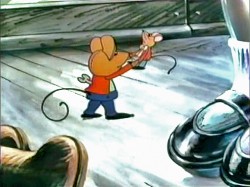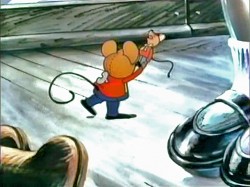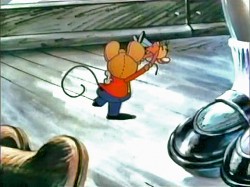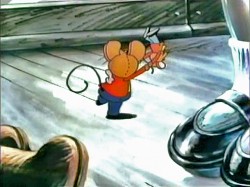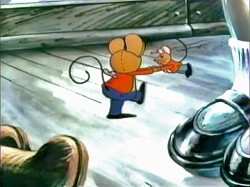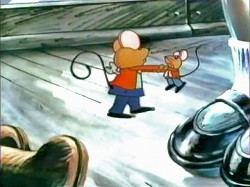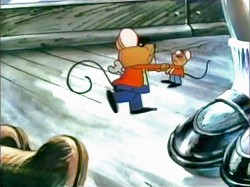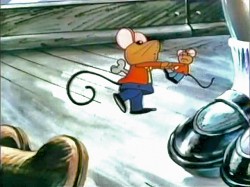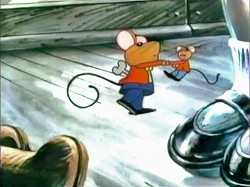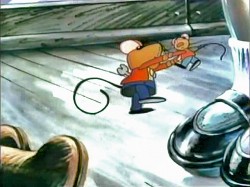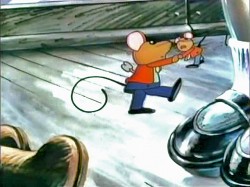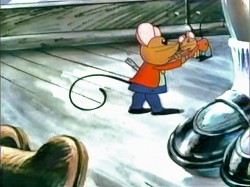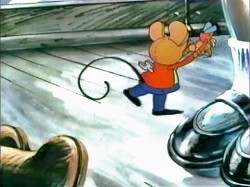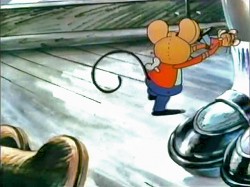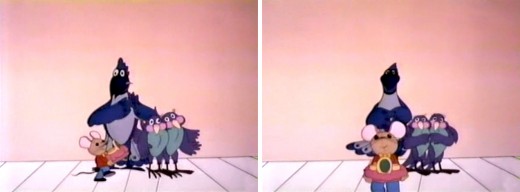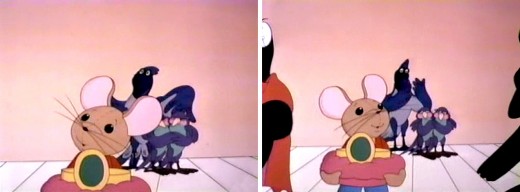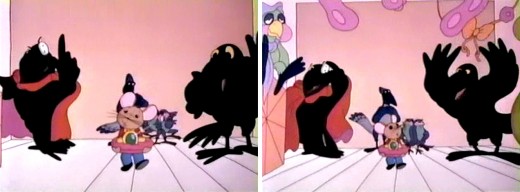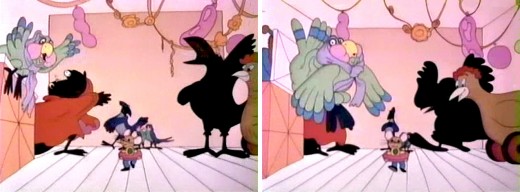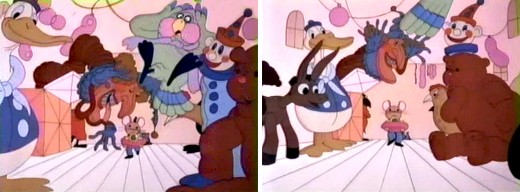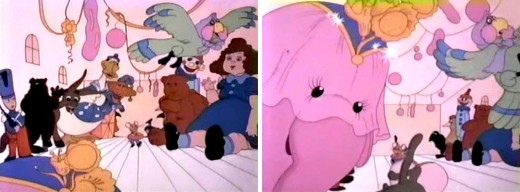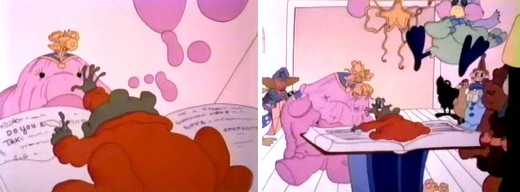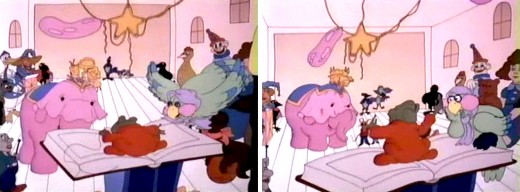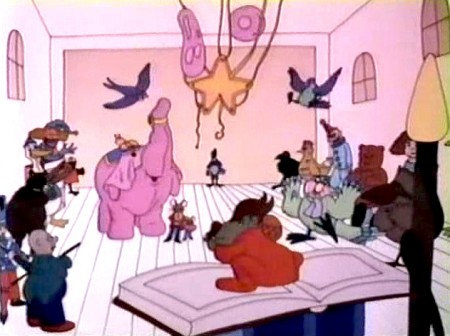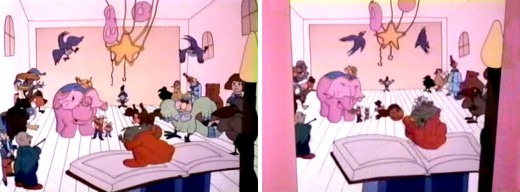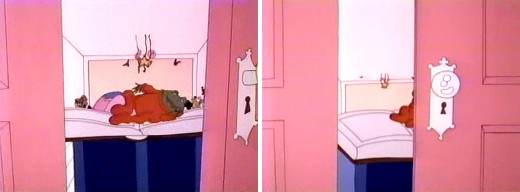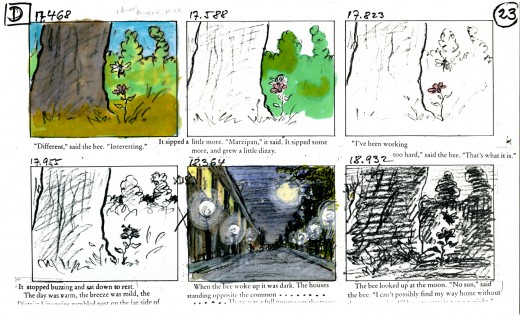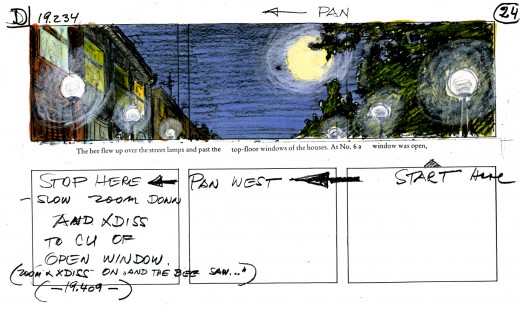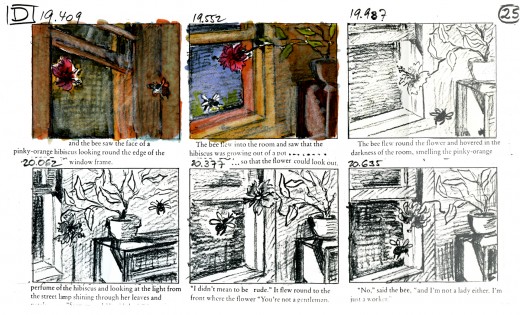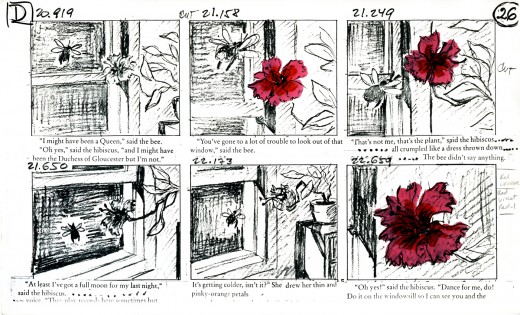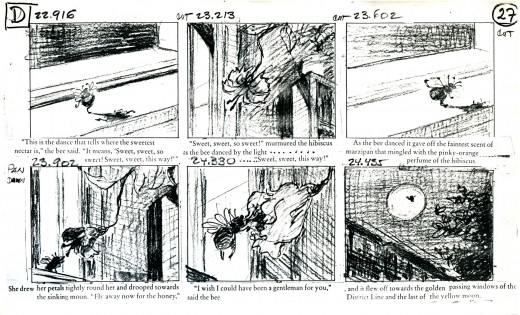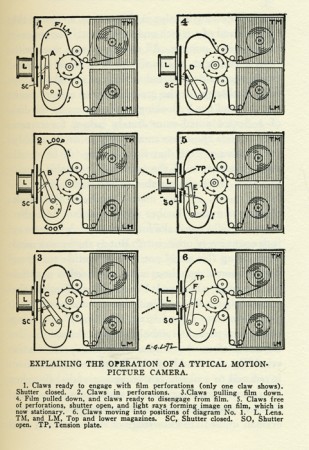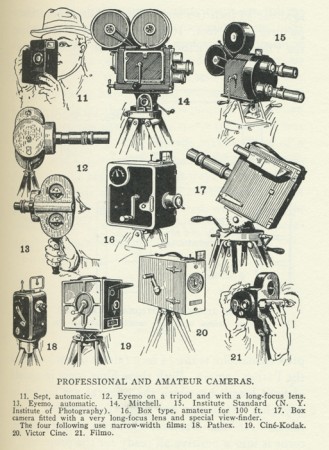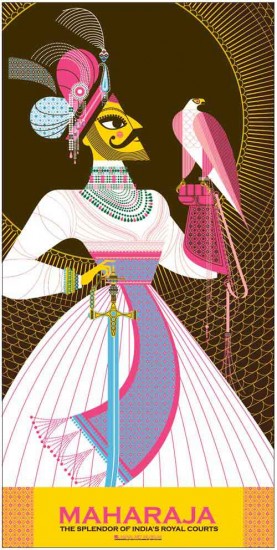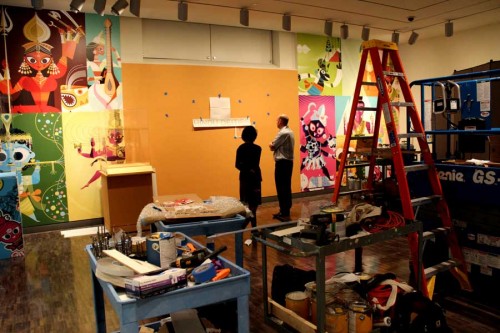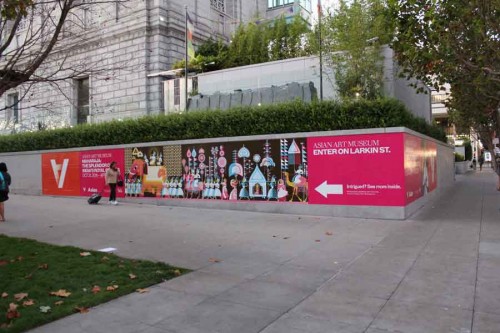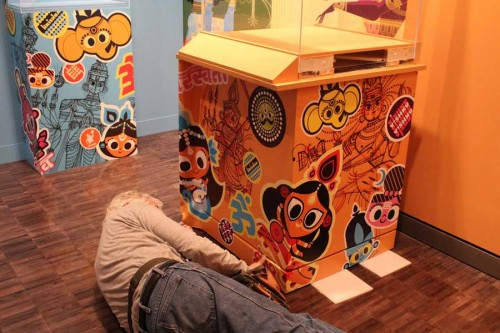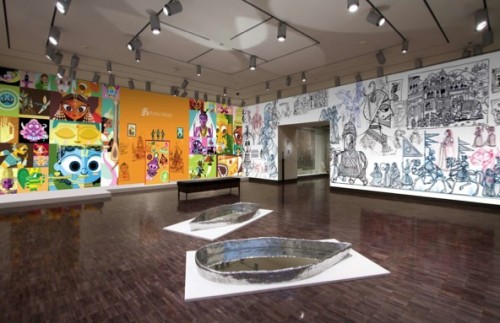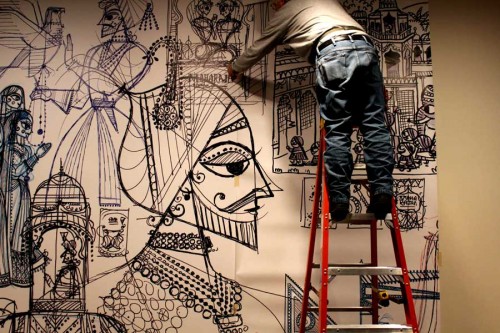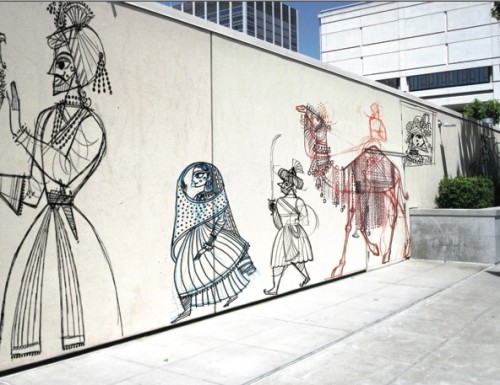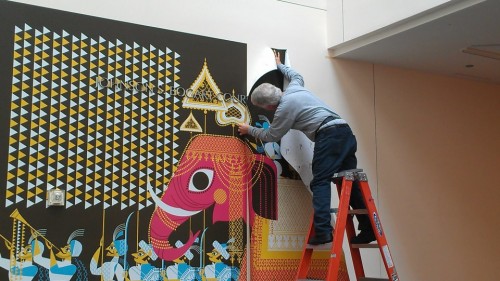Category ArchiveCommentary
Commentary &Independent Animation 19 Dec 2011 06:07 am
The Mouse and His Child Go On
- As I wrote yesterday, the author, Russell Hoban died on Dec. 13th at the age of 86. He was a favorite author of mine. I was lucky to have met him after we completed an animated version of his book, The Marzipan Pig. Prior to that, a feature had been done of his children’s novel, The Mouse and His Child. Here’s a couple of pieces I did about that feature in the past few years.
Sanrio, a Japanese company that made all their money on Hello Kitty products, produced two animated features in the US. Metamorphosis and The Mouse and His Child. Both films failed at the box office. However, The Mouse and His Child, directed by Fred Wolf and Chuck Swenson, has some small glimmers of fine animation throughout the film.
I don’t really know who did any of the animation. Corny Cole, certainly, did the big closing animated zoom of the film. I sought out the work of one animator I liked, and it turned out to be Vincent Davis. It was the first work I saw by him, and I’m still charmed by it.
Here’s a small walk at the beginning of the film. Lots of shape shifting in the assisting, but there’s something nice about it, too. I don’t know who animated it.
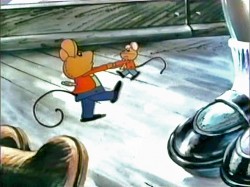 1
1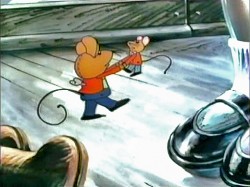 2
2
______(Click any image to enlarge.)
The Mouse and His Child has some real charm. However, it created a small problem for me.
When I’d begun work on The Marzipan Pig, I had to guarantee the brilliant writer, Russell Hoban, who authored both books – The Marzipan Pig and The Mouse and His Child – that no spoken dialogue would be created by me or Maxine Fisher, who was writing the script. Hoban was annoyed by the script for The Mouse and His Child. He felt they had butchered his story.
In fact, the film ends 3/4 of the way into the story. Elements of the last quarter of the book are rushed through the film in one last scene before the end titles. (I have to admit it’s a bit confusing.) This is a scene Corny animated. It’s all one scene; no cuts; an animated BG.
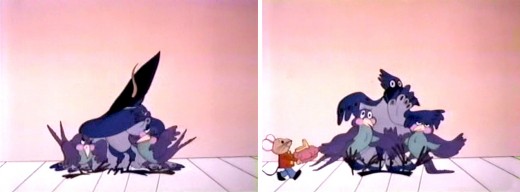
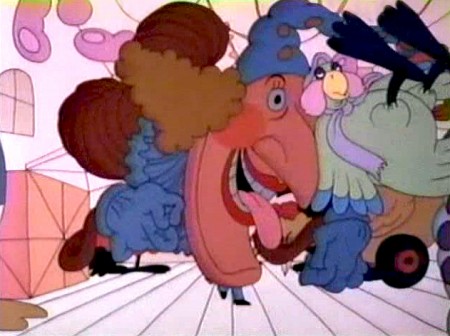
The Jack In The Box looks very different from the guy in Raggedy Ann.
You can watch this film on YouTube.
Commentary &SpornFilms 18 Dec 2011 06:30 am
Russell Hoban 1925-2011
- We couldn’t get by another week without more sad news. I was hard hit yesterday when I learned that Russell Hoban had died on Dec. 13th. He’s been one of my favorite authors for years. I produced and directed an animated version of one of his books, The Marzipan Pig back in 1983. It was not easy getting funding for it. I gave my backer a choice of two of his books, and they were into transubstantiation so it was The Marzipan Pig.
There is a great quote in the Washington Post obituary: “If I am kept away from writing I become physically unwell,†he told the Guardian in 2002.†It is art and the creation of art that . . . make me feel it is a good thing to be part of the human race.â€
Here’s the NYTimes obituary.
Here’s the obit from the Washington Post.
Here’s a great piece from The Scotsman.
When we completed The Marzipan Pig, Hoban came to NY from his home in London. We arranged a screening for him after which Tissa David, he and I went to lunch. In his very dry way, he told me that he was pleased with the film. As I do with all authors, I asked for criticism not compliments, and he told me there was only one complaint. We didn’t get the bridge quite right at the end of the film. Of course he was right, and it’s hard for me to watch those final scenes, now, without thinking about that damned bridge.
I’ve read every book of his I could including at least 60 of the children’s books and all of his adult novels. In film, I know only of the work we’ve done and The Mouse and His Child. Unfortunately, the feature film stopped midway through the book’s story. It’s a brilliant book and what they did of the story carries whatever is happening on the screen. Tomorrow I’ll post some material about that feature.
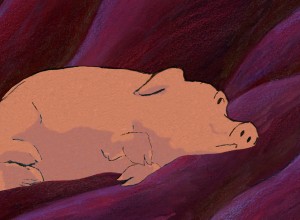 For The Marzipan Pig DVD we included a copy of a section of the animatic. This includes the actual film superimposed over the stills so you can make a comparison as the film runs. Film in film. I like this format; you can really take in the animation and layout of the piece when both are on the split screen.
For The Marzipan Pig DVD we included a copy of a section of the animatic. This includes the actual film superimposed over the stills so you can make a comparison as the film runs. Film in film. I like this format; you can really take in the animation and layout of the piece when both are on the split screen.
I thought I’d post here some of the storyboards and the animatic for that section. Of course, this is in a low res version; more can be discovered in the dvd version.
Tissa David did the storyboard and animated the entire film by herself. This film is a beauty, if I do say so myself. It’s a truly adult film, though it was sold as a family film. It deals with love in all its forms, albeit, obviously, through metaphor. It was adapted from a brilliant children’s book; one of Russell Hoban‘s finest.
Quentin Blake illustrated the original book, and we didn’t purchase the illustrations. Hoban told us that it wasn’t how he’d imagined the pig to look, so he drew it for us. He was once an art director in an ad agency, so he was able to draw. This is the pig we used.
Hoban had hated what was done with his book, The Mouse and His Child, so demanded that all the spoken dialogue in the film be found among his words. We wrote a script; Maxine Fisher went to London to work with him in revising it. Finally, when it came to recording the actor Tim Curry, I threw out the script and had him read the book – with the exception of one line. It was a good decision, and it made for a great performance from a great actor.
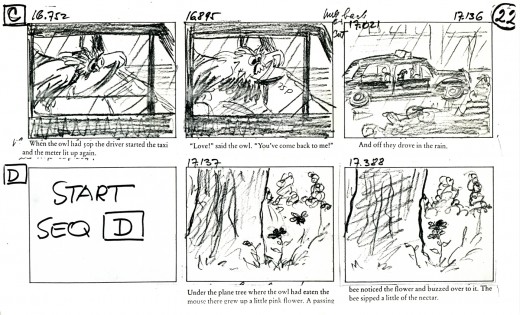
_____________(Click any image to enlarge.)
You’ll notice that some changes were made
in scenes and scene cuts as the animation progressed.
This is typical.
The Marzipan Pig will air on HBO Family Tuesday December 27th
7:30 AM HBO FAMILY – EAST
10:00 AM HBO FAMILY – EAST
10:30 AM HBO FAMILY – WEST
1:00 PM HBO FAMILY – WEST
After that check each month at Michael Sporn Animation.com for future screenings.
Here’s are two films we did for a home video of children’s poems. The first is a poem by Russell Hoban. The animation is by Mark Mayerson, and the design is by Jason McDonald. The music is by Caleb Sampson. I think all of these artists did brilliant work, but then Hoban’s thoughts and words always pull out the best.
Russell Hoban’s The Tin Frog
This second poem of Hoban’s also brought out the best in the artists, Jason McDonald who designed and storyboarded the whole piece. The excellent animation was by Sue Perrotto..
Russell Hoban’s Jigsaw Puzzle
Click left side of the black bar to play.
Right side to watch single frame.
Commentary &SpornFilms 17 Dec 2011 07:23 am
Sightings
This week was another packed week full of tight deadlines and lotsa movies. We finally got the go-ahead for our airline safety film. We contracted in March, started the board in April. The first pass was done by early May, but we went through another dozen versions adapting it to the client’s request. The thing was so tight that I don’t have to do layouts. The client has no conception of how to do animation, so despite the low budget, I have to try to educate them as I make the movie. It’s not fun. The voice recording was done three times. The track is very good, but I also thought the first version was very good.
However, it’s fun to be animating again. Now I have to work like the devil to try to get it done quickly. The budget’s too low to take my time with it.
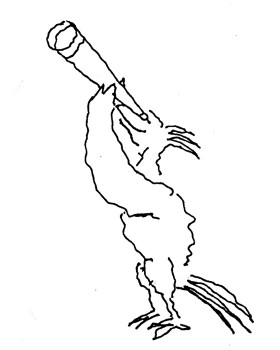 We’re also doing a spot for R.O. Blechman which will go directly to the internet. I’ll post it on this site when it’s done. It was originally to be animated by Ed Smith but he dropped out at the last minute for personal reasons. My loss. However, Matt Clinton, who’s been working with me for the last twenty years (actually it’s only about seven) is animating it. The spot is in good hands. The film is supposed to be done by Christmas. Given that Bob always has revisions, I imagine it’ll go to New Years. Another low budget job. Is that all they make anymore?
We’re also doing a spot for R.O. Blechman which will go directly to the internet. I’ll post it on this site when it’s done. It was originally to be animated by Ed Smith but he dropped out at the last minute for personal reasons. My loss. However, Matt Clinton, who’s been working with me for the last twenty years (actually it’s only about seven) is animating it. The spot is in good hands. The film is supposed to be done by Christmas. Given that Bob always has revisions, I imagine it’ll go to New Years. Another low budget job. Is that all they make anymore?
Other than that, I’ve been seeing movies. There have been a bunch more than usual in that I’m voting for the animated feature. That means I have to see at least 14 of the 18 on the eligible list. This is a hard category. For the most part the films stink. There have been a couple recently that I liked, but those are few and far between. I really enjoyed Rango, and was fortunate to get to meet Gore Verbinski last week. We sat at the same table at a dinner. The film sagged a bit in the middle, but the opening was exceptional.
This past Tuesday I saw a double-bill:
- Gnomeo and Juliet – This is not a film I would have chosen to see, however I was quite entertained by it. Unfortunately I’m still humming Elton John’s songs (“Rocketman” today) after listening to the Elton John songbook playing in the background for an 90 minutes. I thought Emily Blunt’s voice was remarkable. She truly has a voice for animation, and I enjoyed her performance quite a bit. The textures on the garden gnomes was a plus, but the characters seem to be made of feathers not clay. The animation could have done with a bit more weight. This is often a problem I have with CG animation.
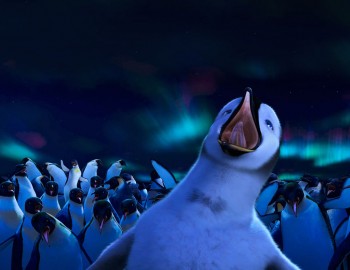 Happy Feet Two was another film that I wouldn’t have selected for myself. However, I really enjoyed it. Finally, an animated film ABOUT SOMETHING. Global warming from frame one of this movie. I loved it. The penguins dance in an inch of slushy water in the opening, as we witness the melting of the polar ice caps. I was a bit confused by the insertion of the Krill brothers. I suppose they were saying that even the smallest of creatures is being affected by the human destruction of the environment. It is the Krill dance underwater that finally knocks down the one ice cap so that the trapped penguin village can escape. The movie moved, and was quite entertaining.
Happy Feet Two was another film that I wouldn’t have selected for myself. However, I really enjoyed it. Finally, an animated film ABOUT SOMETHING. Global warming from frame one of this movie. I loved it. The penguins dance in an inch of slushy water in the opening, as we witness the melting of the polar ice caps. I was a bit confused by the insertion of the Krill brothers. I suppose they were saying that even the smallest of creatures is being affected by the human destruction of the environment. It is the Krill dance underwater that finally knocks down the one ice cap so that the trapped penguin village can escape. The movie moved, and was quite entertaining.MoCap was used for the dancing penguins. All other characters were animated without the aid of the device.
The film also used 3D smartly.
On Wednesday there were another two features:
- Roman Polanski‘s Carnage is his adaptation of the hit stage play by Yasmina Reza. The four actors on screen were brilliant. Kate Winslet, Jodie Foster, John C. Reilly and Christoph Waltz all did superlative work. The film is worth the price of admission just to see Winslet get soused. She’s become a truly sparkling actress. Polanski’s wit is very dry and very dark. I can imagine what some other director
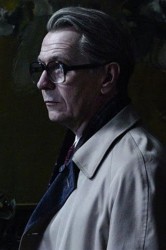 would have pulled in driving home the underlying comedy of this film and was grateful to see him masterfully choreograph this movie.
would have pulled in driving home the underlying comedy of this film and was grateful to see him masterfully choreograph this movie. -
Tinker Tailor Soldier Spy has to be hands down the most subtle of films done this year. A quiet and steady pulse beats trough the magnificent editing of this movie. Gary Oldman’s performance is so quiet that it takes you time to realize how wonderful he is in the part of “Smiley.” There’s no doubt he took Alec Guiness’ version of the character and just added his own subtleties atop that. However, I have to warn you that this film requires the audience to work for its supper. You have to pay minute attention to it or you’ll miss key elements that keep coming at you. I can’t imagine seeing this in DVD unless your eyes are glued to the set and you sit about two feet away from the monitor. It’s worth it; a very good movie.
On Thursday night I saw one film of the double-bill:
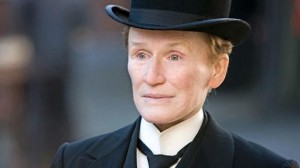 Albert Nobbs stars Glenn Close as a 19th Century woman posing as a man so that she can work without difficulties. This was probably a film I would have waited to see on DVD, but I want to see all films I vote on in theatrical screenings. I’m glad I did. The film was OK, but Close was remarkable. I am not one of her biggest fans – I hated her in Sunset Boulevard -, but I have to hand it to her. This performance was mostly virtuoso. However, it was one of those films where a character alone, on screen, has to say everything aloud so that they can further the exposition. Sorry, people just don’t say everything out loud. I can see why SAG gave her a nomination. However, I think one of the performances of the year was Charlize Theron’s brilliant work in Young Adult. I can’t believe they didn’t even nominate her! Instead, the horrendous Tilda Swinton’s overacting in that amateurish film, We Need To Talk About Kevin, got a nomination.
Albert Nobbs stars Glenn Close as a 19th Century woman posing as a man so that she can work without difficulties. This was probably a film I would have waited to see on DVD, but I want to see all films I vote on in theatrical screenings. I’m glad I did. The film was OK, but Close was remarkable. I am not one of her biggest fans – I hated her in Sunset Boulevard -, but I have to hand it to her. This performance was mostly virtuoso. However, it was one of those films where a character alone, on screen, has to say everything aloud so that they can further the exposition. Sorry, people just don’t say everything out loud. I can see why SAG gave her a nomination. However, I think one of the performances of the year was Charlize Theron’s brilliant work in Young Adult. I can’t believe they didn’t even nominate her! Instead, the horrendous Tilda Swinton’s overacting in that amateurish film, We Need To Talk About Kevin, got a nomination.- War Horse also screened last night, but I’d gone to the World Premiere of that at Lincoln Center. Spielberg and the cast introduced the film which was not a great effort. I would have preferred seeing Black Beauty on the big screen. Even the recent version that starred David Thewlis would have been better. This Spielberg film was all too serious and, as a result, tedious. He stole from John Ford, he stole from Gone With the Wind, he stole from everything under the sun, and it all was too predictable.
 I was sad to learn of Christopher Hitchens‘ death yesterday. He was someone who always made me gnash my teeth while listening to his outrageous political commentary. But he was particularly articulate and intelligent albeit acerbic which always forced me to stay with him. He was an Atheist and argued his points well. I’m sure this didn’t please many watching him on television, though I usually felt in agreement with him on this subject.
I was sad to learn of Christopher Hitchens‘ death yesterday. He was someone who always made me gnash my teeth while listening to his outrageous political commentary. But he was particularly articulate and intelligent albeit acerbic which always forced me to stay with him. He was an Atheist and argued his points well. I’m sure this didn’t please many watching him on television, though I usually felt in agreement with him on this subject.
I watched closely in the last 18 months or so as he very openly talked about his esophageal cancer and how it was forcing him to slow down. It was great to see that the NYTimes gave his obituary front page coverage.
A.O. Scott in the NYTimes praised Brad Bird‘s work in Mission Impossible 6, while appropriately taking the movie with little seriousness. Goodbye Brad Bird, animation director. Neil Genzingler did the dirty work in reviewing the new Chipmunk film, Alvin and the Chipmunks: Chipwrecked. I can’t believe this is one of the films I’m supposed to watch for the Oscar race.
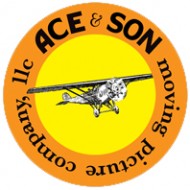 Last night, Friday, I went to a Christmas gathering at Richard O’Connor‘s new company, Ace and Son. I’d been to the space once before after he’d just opened for business. Richard had brought a catalogue from this year’s Ottawa Festival for me, and I went to retrieve it. Then the studio was sparsely decorated, but now it’s starting to feel lived in, with a warm aura about it. They’d just completed their animated Christmas card so shared it with us. We also got a piece of the film as we left, a painted drawing that served as a cel from the film. It’s always fun to take home gifts from parties.
Last night, Friday, I went to a Christmas gathering at Richard O’Connor‘s new company, Ace and Son. I’d been to the space once before after he’d just opened for business. Richard had brought a catalogue from this year’s Ottawa Festival for me, and I went to retrieve it. Then the studio was sparsely decorated, but now it’s starting to feel lived in, with a warm aura about it. They’d just completed their animated Christmas card so shared it with us. We also got a piece of the film as we left, a painted drawing that served as a cel from the film. It’s always fun to take home gifts from parties.
- As of yesterday the IFC Center in NY is presenting 15 films from Studio Ghibli. Mosat of Miyazaki’s masterworks can be seen in this series which runs through January 12th. Here’s a NYTimes article about the screening. The films to be screened will include:
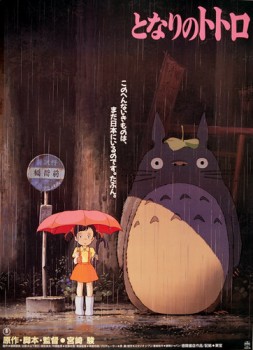 Castle in the Sky *
Castle in the Sky *Wednesday, December 28 – Thursday, January 12
The Cat Returns
Friday, December 30 – Thursday, January 5
Howl’s Moving Castle *
Wednesday, December 28 – Thursday, January 5
Kiki’s Delivery Service *
Friday, December 16 – Thursday, January 12
My Neighbors The Yamadas
Friday, December 23 – Thursday, December 29
My Neighbor Totoro *
Friday, December 16 – Thursday, January 5
Nausicaa of the Valley of the Wind *
Friday, December 16 – Thursday, January 5
Ocean Waves
Thursday, December 29 – Thursday, January 5
 Only Yesterday
Only Yesterday
Friday, January 6 – Thursday, January 12
Pom Poko
Friday, January 6 – Thursday, January 12
Ponyo *
Friday, December 30 – Thursday, January 5
Porco Rosso *
Friday, December 23 – Thursday, January 5
Princess Mononoke *
Friday, December 16 – Thursday, January 12
Spirited Away *
Saturday, December 17 – Thursday, January 12
Whisper of the Heart
Wednesday, December 28 – Thursday, January 5
* Those followed by * are films by Miyazaki.
Go here to see the schedule and the exact times for the screenings.
Commentary &Frame Grabs 12 Dec 2011 06:03 am
Iwerks’ Sinbad
– When I was young, about 12 years old, I saved my money to buy an 8mm projector. This was long before DVDs, before VHS tapes and before even Super 8mm. The used projector cost me $20. I bought it from a NY store called Peerless Photo Equipment. They also had a large department of home market 8mm shorts that could be bought for relatively little money. Lots of Castle films (meaning Universal short subjects 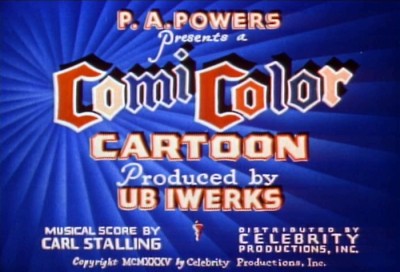 Walter Lantz Woody Woodpecker), a few Disney shorts, a few WB shorts and plenty of Ub Iwerks films. I was an Iwerks fan and my immediate interest was in these films which I had never seen. The same day I bought that projector, I bought a 6 min version of “Jack & the Beanstalk” as well as a 3 min version of “Sinbad the Sailor.” Both were sold only in B&W, and they were silent with a few intertitles. (It’s amazing how well they worked as silents.)
Walter Lantz Woody Woodpecker), a few Disney shorts, a few WB shorts and plenty of Ub Iwerks films. I was an Iwerks fan and my immediate interest was in these films which I had never seen. The same day I bought that projector, I bought a 6 min version of “Jack & the Beanstalk” as well as a 3 min version of “Sinbad the Sailor.” Both were sold only in B&W, and they were silent with a few intertitles. (It’s amazing how well they worked as silents.)
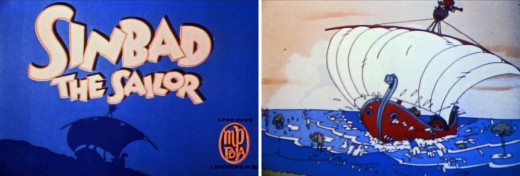
When I finally got to see both films in color it was an amazing surprise for me.
I knew they were in Cinecolor, and I expected much worse than what I got.

With Sinbad, I was surprised at how little I remembered of that film.
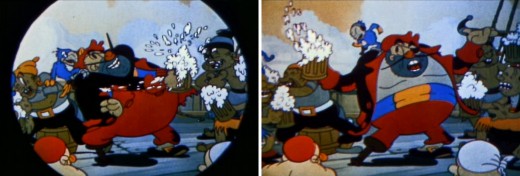
I remembered almost nothing about the pirates. I didn’t forget
Sinbad in the crow’s nest with his parrot espying on the other ship.
I particularly remembered the big bird at the end of the film.
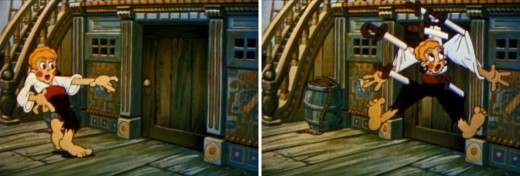
The shortened version did not include this anti-gay joke in it.
Watching it for the first time, I wondered how many other such
jokes were in the films. There were plenty of racist jokes
(including the one I eliminated at the very end of this film.)
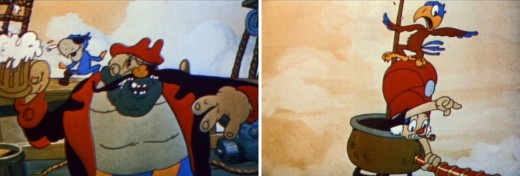
It’s amazing how much those early short films stayed with me over the years,
however this one has just left an impression without my remembering much of
the details of the story.
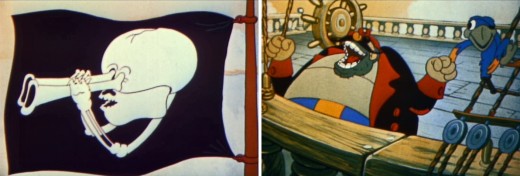
After all, I studied every frame of these films. I’d figured out how to
jerry-rig my 8mm projector to allow me to do that. I could watch each
film one frame at a time.
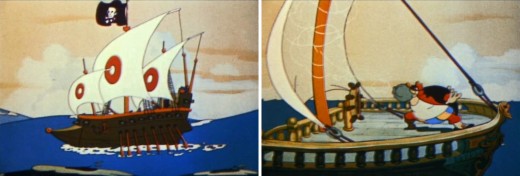
I remember when I first met Grim Natwick that I told him his was the
first animation I ever studied. “Jack & The Beanstalk” left an impression.
Grim wasn’t impressed when I told him.
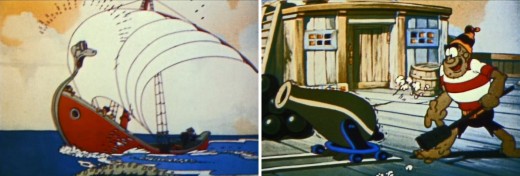
The most I could learn about the crew of this film is that Grim Natwick
(who probably directed) animated along with Stephen Bosustow.
I believe Pete Burness was also with the studio at this time. Berny Wolf
was there at this time and may have animated on Sinbad.
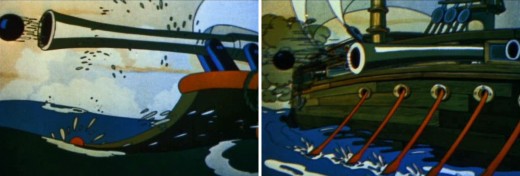
I soon had bought a complete library of animated shorts.
Both “Jack & The Beanstalk” and Woody Woodpecker in
“Ace In The Hole” were favorites of mine back then.
Grim Natwick and Alex Lovy.
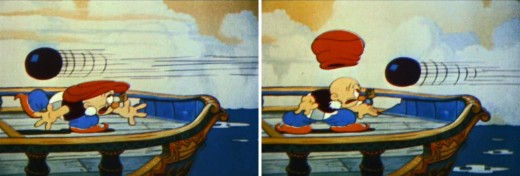
I also bought a couple of WB shorts. I particularly liked the
Chuck Jones directed films. I’d seen “Hair Raising Hare” and
“Rabbit Punch” so many times in the 8mm versions that
it’s almost hard to watch them again.
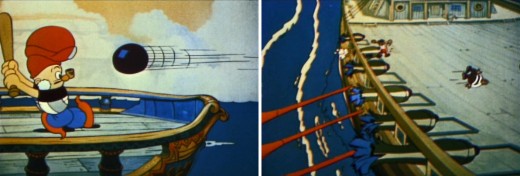
The WB cartoons handled the titles well. They did them
as subtitles, and I liked buying these films for this reason.
Of course, it was a plus that they were such good films.
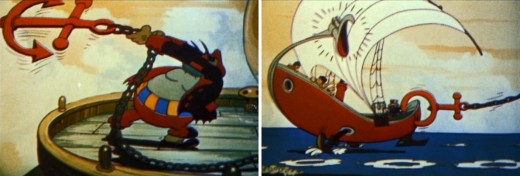
I’m surprised that the Iwerks staff took no attempt to adapt the actual story
of Sinbad from the Arabian Nights, but instead they completely created their own.
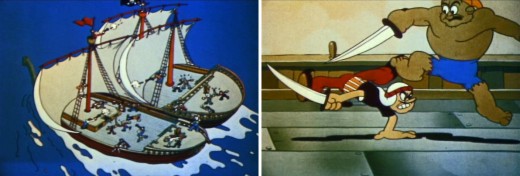
Ted Sears and Otto Englander, were both doing story work for Iwerks,
so they probably had a hand in shaping this film. Eventually, both men
would move on to Disney’s studio where they did exceptional work.
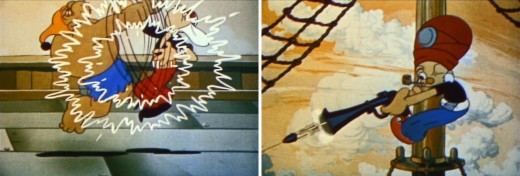
By the time this film was made, Iwerks, himself, had lost interest
in the actual production of the shorts, and he’d tried to get Grim Natwick
to take a piece of the studio to run the production.
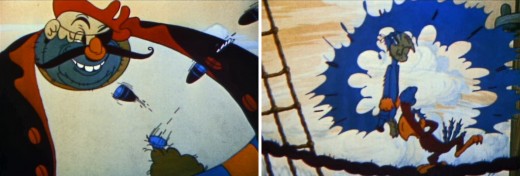
Natwick had refused knowing full well how difficult it was to
manage a studio and try to stay afloat. Especially knowing,
as I’m sure he did, that the studio was in trouble.
He rejected the offer.
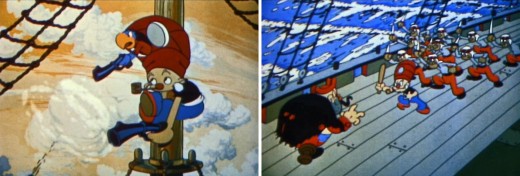
In fact, within a year Natwick, Shamus Culhane and others had
migrated to the Disney studio. Culhane had a side-step going back
to NY to work under Bert Gillette for Van Buren. When that ended
badly, Culhane went to Disney to work for less than he made in NY.
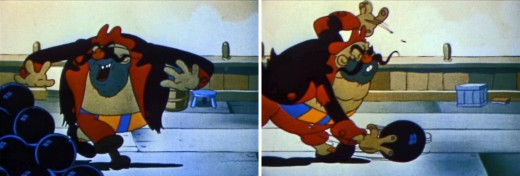
Berny Wolf, Al Eugster and Steve Bosustow also moved to Disney’s.
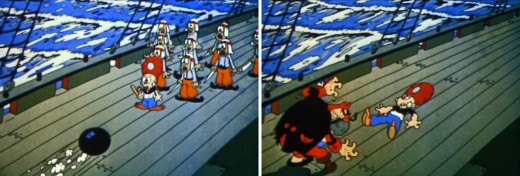
The bowling pin joke has got to be one of the older jokes used in animated films.
I’m sure the addition of sound helped sell the gag during the early sound years.
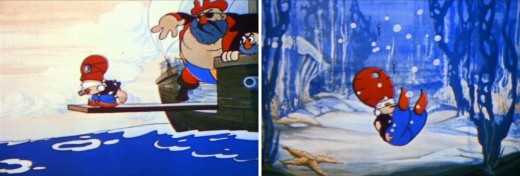
Others at the studio such as Chuck Jones and Frank Tashlin
as well as Bugs Hardaway and composer, Carl Stalling,
moved over to Schlesinger’s studio at Warner Brothers.
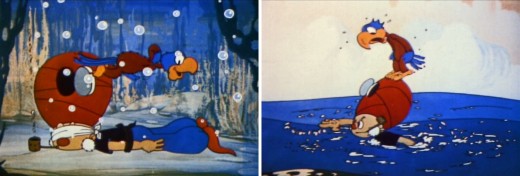
“Sinbad” was part of a trilogy of films Iwerks made from the
Arabian Nights. There was also “Aladdin” and “Ali Baba.”

All three were really just titles to hang a cartoon on.
These were part of the attempt to try to gain a bit of success
after Willie Whopper and Flip the Frog had both failed as series.
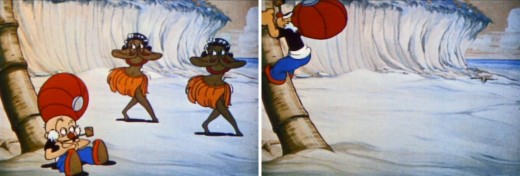
There’s no doubt that Grim Natwick did these dancing girls.
It was his signature style at the time.
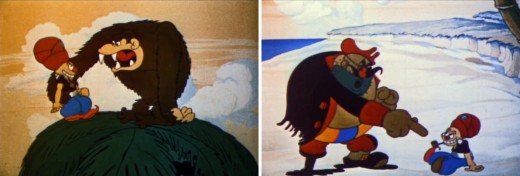
Iwerks was moving his studio to the edge of the precipice.
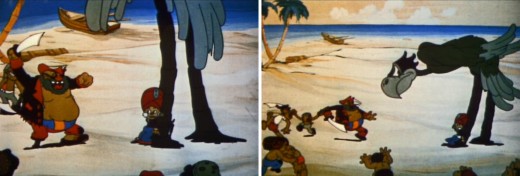
Iwerks introduced his version of the multiplane camera about
this time, trying to offer something new to the medium.
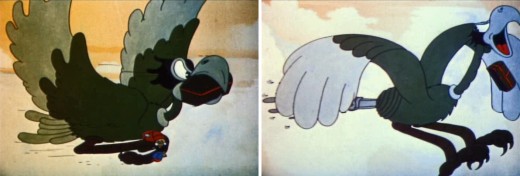
The Headless Horseman and The Valiant Tailor both showcased
the multiplane camera in its production. Neither took off.
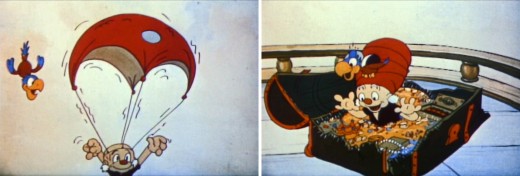
It wasn’t much longer before the Iwerks studio
floundered and ultimately died off.
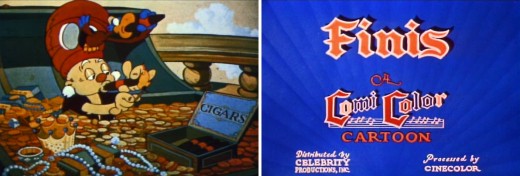
The final joke (cut out) shows the cigar exploding leaving
Sinbad with a black face with just a touch of racist humor.
________________________
.
Here’s the YouTube version of this short.
Commentary 10 Dec 2011 07:10 am
Linkage
- There will be a memorial service for Vinnie Cafarelli at Buzzco on January 6, 2012 from 4:00 to 9:00pm. More information will be relayed at this site when we get closer to the date.
I’ve been visiting a lot of sites and blogs lately and would like to share links and make a few comments about some of them.
Let’s start with the sites/blogs I visit every day, some of them several times a day, knowing there’s a lot to take in or there will be updates. I’m sure you visit most of these as well; they are the staples for the animation community.
The Daily Stops

Cartoon Brew, of course, is the place to get a lot of information first. Jerry Beck and Amid Amidi each has a specific taste, and together they combine to make something that captures a very wide audience. There is a lot of first-hand news flashes as well as material they’ve culled from other sites. The only annoying part of the site comes in the “comments” section where the crazies come out to make their inane comments. Of course, it doesn’t bother me enough to not read most of them.

Mike Barrier for many years was the publisher, editor and prinicipal writer for the most important magazine devoted to animation, Funny World. (I’ve been rereading several issues – currently #13 – and can’t believe how much information I’m still getting out of some of the writing.) The site is every bit the same as the magazine, except it comes more frequently. The writing and research is first rate and the material presented is always deeper than others have offered. This is a necessary stop for anyone even remotely interested in animation. He’s fiercely opinionated, but often has good reason backing up that opinion. (Though he still admits to liking POLAR EXPRESS.) His writing style is the best on the web with a superb vocabulary and well considered choice of words.
I don’t miss a day without visiting this site even though Mike sometimes will take a month off (notifying us in advance) from writing. However, I want to get the new posts the moment they’re up; it’s that important to me.

- Mark Mayerson‘s blog is my third stop, daily, on my rounds. His comments are always sharp and well thought out. His writing is done in a businesslike approach – no frills and no nonsense. His news items are often off the mainstream and definitely worth visiting. The finest part of this site is when Mark comments on a film or short or analyzes the makeup of a scene (see his 14-part take on a short sequence from Ford’s Stagecoach.) Often even Cartoon Brew lifts news items from Mark’s site. The comments section is usually from those who are knowledgeable, so they’re worth reading.

- A Film LA is Hans Perk’s great blog. This is a wonderful resource of a site. Hans posts drafts to many of the Disney films.. He also posts invaluable items from the Disney archives. I love this site for the information I pull from it and study.

Eddie Fitzgerald is one of the most creative guys on the Internet. His blog, Uncle Eddie’s Theory Corner, keeps changing about four or five times a week, and it’s always a genuine treat. He creates photo-montage essays that either are outright hilarious or somewhat serious. Just in the last two days he went from “THE AMAZING SLUMS OF RIO” to “HOW GERMANY GOT OUT OF THE DEPRESSION” to “SHOULD ANIMATION CHARACTERS WEAR WIGS?” From recipes to animation analysis to photo-cartoon comics, you never quite know what you’re going to find here, but it’s always fun.
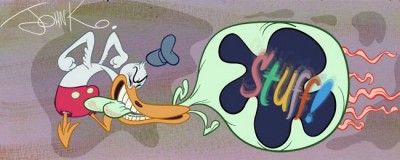
John Kricfalusi‘s blog is a must read for animators. He often gives advice, which is usually skewed to his particular style of cartoony animation. It’s a different world if you’re a Disney-esque animator, but it’s vital that even you know what’s on his mind, because it’s always written from a sure knowledge of animation theory. I would have loved seeing what he might have done with Aladdin’s Genie. Eric Goldberg did a perfect job, but John K might have take it to the farthest reaches.

The Animation Guild Blog (TAG Blog) is the animation guild’s blog which is primarily written by Steve Hulett. It changes at least once a day, and focuses mainly on the business side of animation. There are also excellent audio interviews with animation veterans who talk about their history. At times the creative side of animation is also discussed. This is an important blog to read to get information from. I find the comments generally well informed and the discussions there usually on a high level. However, most of the commentators generally label themselves as “anonymous” which is more than a little annoying. It gives a good indication of the fear floating politically in the business.
.
At least Weekly Stops

Signe Baumane‘s site, named after the feature she’s creating, Rocks In My Pockets, contains some of the best writing on the web. Signe’s stories from her life read like fantastic adventures through a unique universe. They’re all so personal and so vivid in their imagery that they could only have been written by an animator.
I’m hooked on this site and I turn up religiously to see if something new has appeared.
.

- I’ve gotten to enjoy Gene Deitch’s blog, Gene Deitch Credits. He gives commentary about a number of the people he’s come in contact with over the years and writes short essays about each of the individuals. I enjoyed his take on John Hubley, Jim Tyer, Jam Handy, Bill Hurtz and especially Phil Scheib. As a matter of fact, I like them all. So little of worth is usually written about some of these people, and Gene’s personal comments are usually gold. I do wish some of them were longer. However, that’s better than wishing they were shorter.
.
Countdown of the 50 Most Influential Animators in Disney Studio History
- Someone who tends to overwrite is Grayson Ponti at 50 Most Influential Disney Animators. His idea of putting out a list of the top 50 animators in Disney history is an ingenious one – except, of course, that you ultimately run out of numbers. This will happen soon, since he’s down to the top two. He’s announced a follow-up blog when he completes the top 50.
Each entry is extensive in length and usually filled with typos and hard-to-comprehend writing errors so it takes a bit of time to wade through the posts. It must take quite a while for him to write these pieces, it’d be worth his rereading them to correct errors.
Often, however, there are a lot of interesting comments that Grayson posts that make you think back to some of the scenes of the animators under discussion. I can’t say I’ve disagreed with much that he’s written, thus far.
Another problem I have with the blog is that he lifts images from many other sites without giving appropriate credit. Many of the drawings and cels lifted are in personal collections, and he should let his readers know.
- Dan Caylor has a good site called On Animation. It offers a lot of videos and news briefs. Many of these videos (all in a large format) will also show up in places like Cartoon Brew, but there are those I’ve only been able to see at this site. A good example is a wonderful piece showing the back stages of Aardman‘s puppet making for their film Pirates. This is a 17 minute piece that really gives an in depth look at the size of the puppets, not to mention the size this production. Quite informative.
The site is well worth visiting to see what new film shorts have been posted.

Steven Worth had created the site for the ASIFA Hollywood Animation Archives. That site is still up, but the links weren’t working and you couldn’t access the archive. Now Steven has started this site, Animation Resources, and is quickly posting all those original links from the old site. There’s too much valuable artwork to not see it accessible; so it’s great that we can now get to it.
Recent Finds

I came across this French title designer this past week and was quite impressed. You can see a number of Laurent Brett‘s title sequences at the site. The link appeared on the Steven Heller post about the film titles for OCS 117 on Imprint magazine. However, I found all of his work quite interesting.
Laurent Brett‘s title design.
There are so many other blogs and sites that I can’t continue here. Perhaps I’ll pick it up at another time. I suggest you scroll through my blogroll on the right of this page to see what else is there (in case you don’t know about one or two of them.) I’ve barely scratched the surface. Andreas Deja’s blog, DejaView, is a miracle of animation drawing, Scribble Junkies is another voice for Bill Plympton and Pat Smith, Hans Bacher’s beautiful blog, One1more2time3, is necessary viewing, Alltop is a great way to surf the top few animation blogs. There are so many more; I will continue this.
Books &Commentary &Layout & Design 06 Dec 2011 06:37 am
Setting the Scene – Book Review
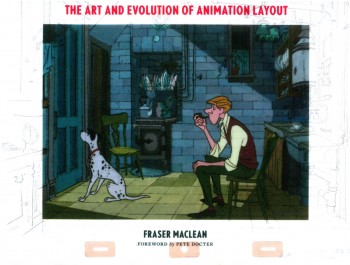 - Setting the Scene: The Art and Evolution of Animation Layout is a beautiful new book by Fraser MacClean. This is a stunningly attractive book with a great number of illustrations going all the way back to Winsor McCay right up to recent Dreamworks films.
- Setting the Scene: The Art and Evolution of Animation Layout is a beautiful new book by Fraser MacClean. This is a stunningly attractive book with a great number of illustrations going all the way back to Winsor McCay right up to recent Dreamworks films.
The book talks about the history of the layout artist and gives plenty of examples from the past to the present, 2D to CG. It addresses how McCay did his films, through the silent animation era, past the Golden Age of animation, right up to the present day’s more complicated methods for computer graphics. It’s a wonderful and heavily researched book with an enormous number of illustrated examples.
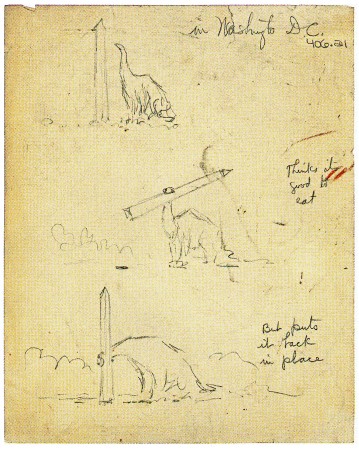
A Winsor McCay LO for Gertie
Original drawn layouts for the likes of One Hundred and One Dalmatians, Chuck Jones/Maurice Noble shorts, Betty Boop shorts, Gulliver’s Travels and The Thief and the Cobbler dress this book giving it a strength that none of the words could offer. Storyboard sequences for Peter Pan, The Rescuers Down Under, Cinderella or Song of the South help get any point across in the most visual way possible.

The book is somewhat dense and took me quite some time to go through it carefully. The material is so interesting, though, that I was ready to give it all the time necessary. Every time you turned a page there’d be another beautiful illustration that just took a lot of time to study.

A planning drawing for the great multiplane scene in Pinocchio

from B&W to color
Johnn Didrik Johnsen’s LO for Tom & Jerry “Puppy Tale” (1954)
Probably my only complaint about this book would be that the type is small and harder to read. At times even the illustrations are a bit smaller than I’d like. This, of course, is because anything larger would require greater printing costs and make the book too expensive. So, I’d rather have what sits in my hand than something I’d think hard about buying. As it is, the book is a must own for animation enthusiasts, and there’s a lot to learn for anyone interested in the process of animated film making. I wouldn’t hesitate to wholeheartedly recommend this book to anyone.
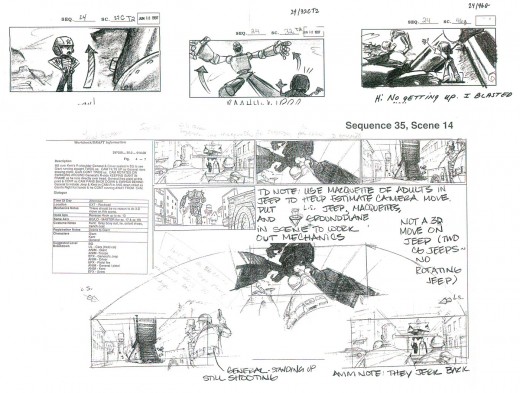
Brad Bird’s planning sketch for “The Iron Giant”
I could keep pulling more and more illlustrations from this book. They’re all unique and totally illustrate what the author is talking about at the moment. And they’re all gorgeous. You have to take a look at this book. It’s is another beautiful book from Chronicle Books. They are batting a perfect score, as far as I can see.
Commentary &commercial animation 04 Dec 2011 07:51 am
Vince Cafarellii (1930-2011)
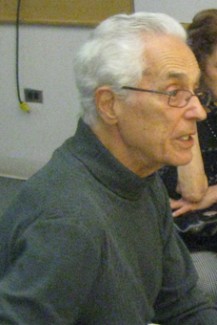 - I’m sorry to report the sad news that Vincent Joseph Cafarelli died in his sleep yesterday.
- I’m sorry to report the sad news that Vincent Joseph Cafarelli died in his sleep yesterday.
He was 81 years old.
“Vinnie” was a principal mainstay in the New York animation industry. He worked at Famous Studios on classic characters Popeye, Little Audrey and Baby Huey.
Later he worked at Gifford Animation on such advertising campaigns as the Piels Brothers and TipTop Bread. Margaret Hamilton provided the voice for Emily Tipp! You can go here to see 3 examples of the TipTop Bread commercials produced in the 1950′s.
Vince joined Stars and Stripes Forever, Inc, as their first employee upon his return from London, England where he worked with Pablo Ferro. Stars and Stripes was owned by producer Bob Staats and designer Len Glasser. They became the hottest boutique shop in the psychedelic 60’s creating such classics as: Chicken of the Sea “Mermaidâ€, Speakeasy, Sparklettes, and Ortho.
While at Stars and Stripes Vince worked with designer, Hal Silvermintz and film editor, Buzz Potamkin. Those two left to form Perpetual Motion Pictures, Inc. and after Stars and Stripes folded, Vince went to join them. There he was responsible for many ad campaigns and co-directed Strawberry Shortcake in Big Apple City and animated on all 5 Berenstain Bears holiday specials. He co-directed Deck the Halls With Wacky Walls.
Ultimately, Vinnie joined with Candy Kugel to form Buzzco Associates where he remained to the end. The two of them worked together for many years. You can check out a gallery of his art at AWN.
I’ve known Vinnie for 35-40 years, and can’t think of a sweeter gentler soul in animation. Most recently we’ve met on a number of occasions at the Academy. We spent a lot of the ten hours watching the long list of shorts and had a good time talking about them. I’ll miss his presence. My heart goes out to his family as well as Candy Kugel and Marilyn Kraemer who’ve spent every day with him for the past forty-odd years together. The three were partners in business and friendship and were completely dependent on each other.
More details of his life as well as information on memorial services will be forthcoming later. Buzzco is intending a memorial to take place on the Epiphany, January 6th, 2012; I will make sure to post further information on this site.
Books &Commentary 29 Nov 2011 06:35 am
Overdue Review – The Motion Picture Cameraman
- A couple of weeks ago, I reviewed the E.G. Lutz book, Animated Cartoons. I was also intrigued by another of his many books, The Motion Picture Cameraman, and quickly ordered a copy from Amazon. This 1927 book is obviously dated, but like his earlier book, Animated Cartoons, it’s so filled with information that most of it has held up over the years. Of course, today everything is digital, so there’s no need for a lot of information about film and film stocks, but there’s still of lot to be learned for the aspiring motion picture photographer.
This is all illustrated by detailed drawings by Lutz, himself.
The book starts out talking about the camera. Lutz, at first, sticks to the simplest, the box camera, and moves on from there ultimately comparing and contrasting a number of different makes, at the time.
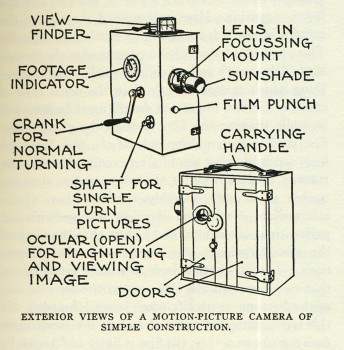
The simple box camera
The book offers lots of charts and details that are pertinent to the subject. Everything from filming outdoors “When subjects have a preponderance of red and yellow hues they require a large stop and a long exposure to procure any kind of result. In subjects where blue and violet prevail a smaller stop will do.” Naturally, there’s a chart analyzing daylight hours at different months of the year.
He has an entire chapter on shooting within a studio of the period: “A Motion-Picture studio is a huge structure with glass roof and sides in which artificial lights supplement daylight, or are used exclusively for the illumination.” Certainly, this is not what studios were even five years on. They would soon be doing color, and they would need to very carefully control the conditions for photography.
How quickly it all changed and how casually we shoot now with our digital cameras.
He has a chapter on effects photography covering everything from glass matte shots to split screen photography. Many of these effects are illustrated.
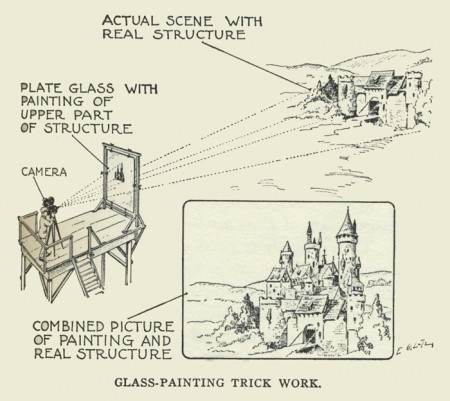
The glass matte shot explained in a very clear way
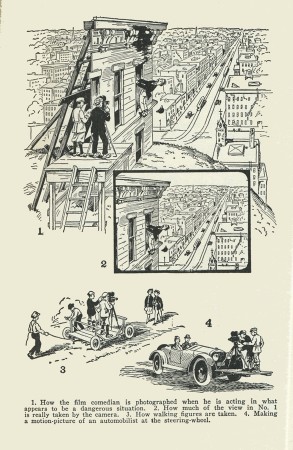
How people hang precariously
from clocks in silent films (see Hugo).
He has an entire chapter on how titling is done, and there’s another chapter on “‘One Turn, One Picture’ Work”, or as we call it “animation.” The “one turn, one picture” means that you crank the camera only once around to film one image. It took 16 cranks to shoot one foot of film, or one second in the silent pictures. Film ultimately went to 24 frames per second to accommodate sound photography.
In that animation chapter, he analyzes the different types of animation from cut-out to stop-motion to time-lapse photography. It’s very succinct and well informed, as we might expect from the author of the first how-to book on the subject.
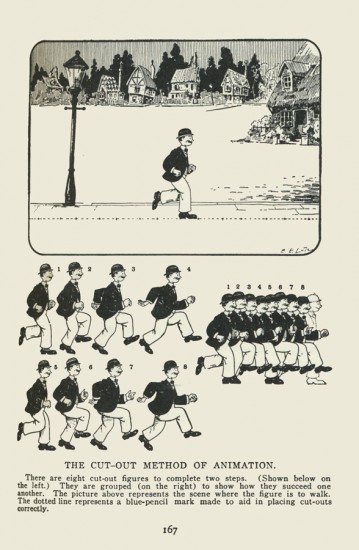
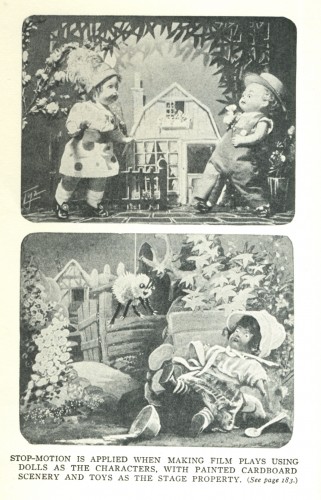
Puppets, prior to the ball and joint method
were just strung together with strong wire.
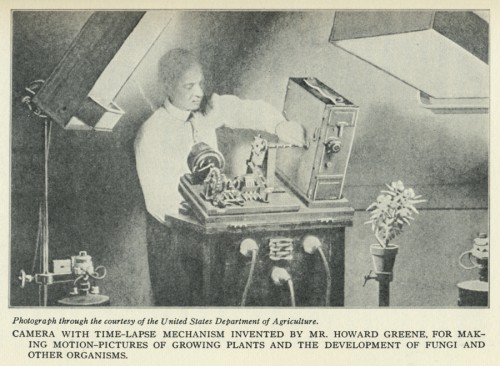
This man is shooting a time-lapse film although
it looks as though he were creating Frankenstein’s monster.
Ultimately, we even get instructions on how to develop the film. Fortunately, labs were created for that purpose and handle such an important part of the process today.
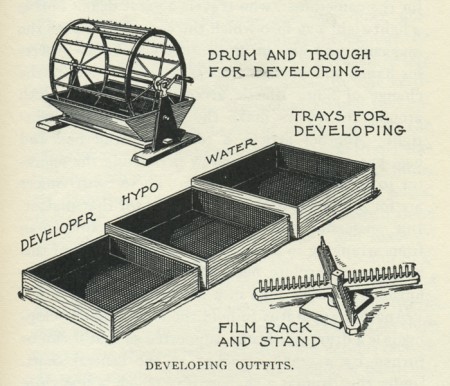
Equipment needed to develop your own film.
I guess the book seemed valuable for me because I have an interest in the process, both that of the past as well as that of today. I’m not sure everybody has that interest, but this book will serve you well and entertain if you do.
Commentary &Photos 27 Nov 2011 04:41 am
Mean Benches – repost
- Has anyone else noted that the world has gotten meaner? Just watch one of the Republican debates for proof positive of that. Or take a look at what’s happening to the protesters of the Occupy Wall Street movement. Pepper spray anyone?
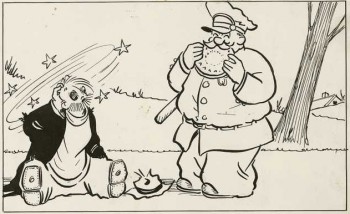 Remember the comic strip Pete the Tramp by C.D. Russell? no, it’s probably before your time. Pete was a tramp who stole pies from windows and got in trouble with the law. He was the typical hobo in comic strip form, and the strip started during the depression and lasted through 1963. I read it in color in Saturday’s NY Journal American.
Remember the comic strip Pete the Tramp by C.D. Russell? no, it’s probably before your time. Pete was a tramp who stole pies from windows and got in trouble with the law. He was the typical hobo in comic strip form, and the strip started during the depression and lasted through 1963. I read it in color in Saturday’s NY Journal American.
Pete usually slept on park benches under newspapers and got his feet slapped by the cop. I noticed park benches this week and wanted to call attention to the way our society has handled tramps, hoboes, homeless people. In New York, they’ve made them uncomfortable.
This is the park bench I noticed.

It’s a bench in Madison Square Park, and I noticed it because it’s become a relic of the past. A person could actually sleep on it.

This is the newer model. The only way you could sleep on it is if you only had a torso. They’ve put dividers there, so it makes it handy to sit and not touch the person next to you, but you couldn’t really lie down on it.
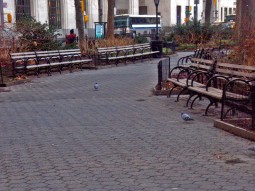

See. There are lots of these now. Madison Square Park is made of mostly these benches, but there are still a couple of the old kind.


The new little park down on Bleecker and 6th Avenue only has this type of bench.
No vagrants wanted here.
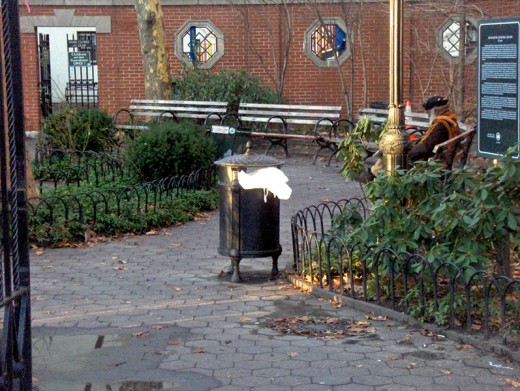
Even the old, tiny private park on Bleecker has these newer benches. (I did see someone sleeping on them, but I couldn’t get close enough to photograph the way he mangled his body to get some sleep.)


A building up on 28th and Madison made sure no one could sleep on their public seating area.

Subway benches have also become completely inhospitable.


This type bench has very tight dividers. Wearing winter garb, one hardly fits into the space. However, these benches aren’t quite so bad in that the dividers aren’t mercilessly high.

Look at these uncomfortable things at West 4th Street. (Plenty of homeless used to be downtown.)


You could hurt your back trying to sleep here. Though, I have seen some people stretched out over these partitions. That’s how desperate it gets in the winter cold.


It’s not too much better on the subway. The seats are lumpy – shaped for the bum (I don’t mean vagrant-like bum) in bright colors. It’s a tight squeeze.

The few longer seats are “Priority seating.” This means bums have to get up for older people. I’m not sure what it means if the bum is an older person.

__________(Click any image to enlarge.)
.
This is a repost from January 2008. The world has gotten even meaner since then.
Art Art &Commentary &Illustration 26 Nov 2011 07:42 am
Patel’s Pictures at an Exhibition and Gene Deitch’s Chopsticks
- After I’d posted a review of Sanjay Patel‘s most recent publication, The Big Poster Book of Hindu Deities, he sent me some information about an exhibit opening in San Francisco at the Museum of Asian Art. Included in the email were a number of photos of the exhibition setting up. I’ve chosen some to post which follow below:
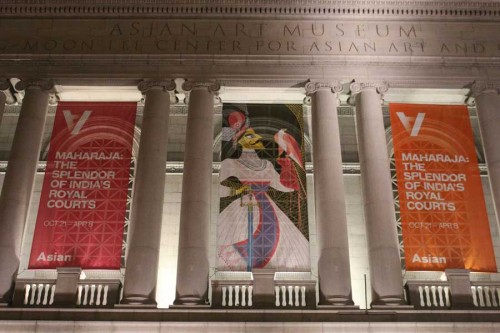 1
1The banners outside the Museum
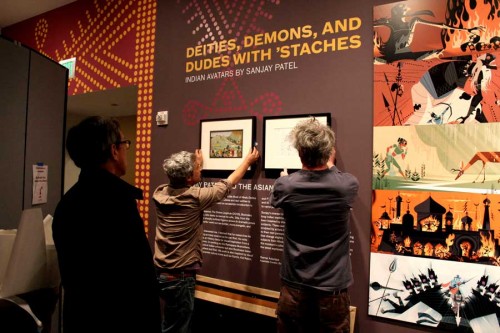 2
2
Setting up the exhibit’s entrance sign
More pictures can be found on Sanjay’s site.
I’ve also found this short video piece about his work and thought I’d share it with you. It’s quite informative.
Mr. Patel also had an exhibition of some of his work which is reviewed here in the Asian Art Museum in San Francisco and here in the New York Times.
I received this note from Gene Deitch in the past week:
 . . . it seems nearly impossible to buy anything that’s not made in China or some other competitive distant land that’s taken over our jobs. I thought we had no other choice but to give gift certificates to local services, to benefit our own workers.
. . . it seems nearly impossible to buy anything that’s not made in China or some other competitive distant land that’s taken over our jobs. I thought we had no other choice but to give gift certificates to local services, to benefit our own workers.
- But lo! The brand new December, 2011 issue of National Geographic magazine, published in Washington DC, and totally reliable for the truth, has come out with the news that chopsticks, necessary for all Asiatic food, are actually Made in USA, in Georgia, and exported to China and other far east, forkless regions!
Consider a gift parcel of this traditional American product!
- (A subscription of National Geographic itself would also be great, but not without warning of the a trap I myself have fallen into. It’s impossible to give the National Geo for a single year! Once begun you are hooked for a lifetime of renewals! The magazine is so precious, so informative, and so beautifully printed, that it’s not too discardable. We ourselves have had to move four times to progressively larger quarters, just to accom-
modate the ever growing shelf space needed since I started my subscription in 1946!)
